Delaware River Drive | |
|---|---|
| Route information | |
| Existed | 1911–1916 |
| Major junctions | |
| South end | West State Street in Trenton |
| North end | New York border in Montague Township |
| Location | |
| Country | United States |
| State | New Jersey |
| Highway system | |
Delaware River Drive was a state highway in the U.S. state of New Jersey.
A 1913 map of the proposed New Jersey State Highway System with an accompanying report shows the route of the Delaware River Drive beginning at the State Capitol on West State Street in Trenton. It then followed West State Street and Sanhican Drive to the city limits, then followed present-day Route 175 to present-day Route 29 to Frenchtown.
From Frenchtown north, the Delaware River Drive followed County Route 619 (CR 619) into Milford, where it met CR 519, following CR 519 a short distance to the center of Milford. North of Milford, the route followed CR 627 as far as Riegelsville, then continued along River Road to Carpentersville, and Carpentersville Road to Phillipsburg.
The Delaware River Drive continued north of Phillipsburg on present-day CR 646 to CR 519, following CR 519 through Harmony and Roxburg to CR 620, which took the drive into Belvidere, the county seat of Warren County, and beyond to U.S. Route 46 (US 46).
The route then followed the present US 46 through Manunka Chunk to Columbia; the Delaware River Drive between Columbia and Dunnfield has been obliterated since 1953 by an alignment of the former US 611, now part of Interstate 80 (I-80).
North of I-80, The Delaware River Drive follows the historic Old Mine Road for much of its route to the New York state line at Montague Township in Sussex County. Much of this section is through the Delaware Water Gap National Recreation Area. North of US 206, the Delaware River Drive follows CR 521. [1]
Legislated in 1911, [2] this was New Jersey's second state highway. Legislation in 1913 provided for the extension of the Delaware River Drive to Cape May. [3]
The Egan Bill of 1916, [4] and the Edge Bill of 1917 [5] did not provide for a route along the Delaware River; the Delaware River Drive may be considered to have been decommissioned by these acts.
This route, and the Ocean Highway predated any highway numbering system in New Jersey, and may be considered a transition between the early auto trails and modern state highways.

Route 12 is a state highway located in Hunterdon County, New Jersey, United States. It runs 11.69 mi (18.81 km) from the Uhlerstown–Frenchtown Bridge at the Delaware River border with Pennsylvania in Frenchtown east to an intersection with U.S. Route 202 and Route 31 at the Flemington Circle in Flemington. The route is mostly a two-lane undivided road that passes through rural areas of woodland and farmland. It intersects Route 29 and County Route 513 in Frenchtown, CR 519 in Kingwood Township, CR 579 on the border of Delaware Township and Raritan Township, and CR 523 in Raritan Township.

Route 23 is a state highway in the northern part of New Jersey, United States. The route runs 52.63 miles (84.70 km) from Bloomfield Avenue and Prospect Avenue (CR 577) in Verona, Essex County, northwest to the border with New York at Montague Township in Sussex County, where the road continues to Port Jervis, New York, as CR 15. Route 23 heads through Essex and Passaic counties as a two- to four-lane surface road and becomes a six-lane freeway north of a complex interchange with U.S. Route 46 (US 46) and Interstate 80 (I-80) in Wayne. The freeway carries Route 23 north to run concurrently with US 202. Past the freeway portion, the route heads northwest along the border of Morris and Passaic counties as a four- to six-lane arterial road with a wide median at places, winding through mountainous areas and crossing the interchange with I-287 in Riverdale. The route continues northwest through Sussex County as a mostly two-lane surface road that passes through farmland and woodland as well as the communities of Franklin, Hamburg, and Sussex before reaching the New York state line, just south of an interchange with I-84 and US 6 in Port Jervis, in Montague Township near High Point State Park.
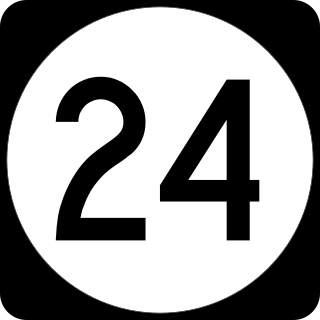
Route 24 is a 10.4-mile (16.74 km) freeway in New Jersey, United States, that begins at a junction with I-287 in Hanover in Morris County, passes southeast through Essex County, and ends at an interchange with I-78 in Springfield in Union County.

Route 29 is a state highway in the U.S. state of New Jersey. Signed north-south, it runs 34.76 miles (55.94 km) from an interchange with Interstate 295 (I-295) in Hamilton Township in Mercer County, where the road continues east as I-195, northwest to Route 12 in Frenchtown, Hunterdon County. Between the southern terminus and I-295 in Ewing Township, the route is a mix of expressway and boulevard that runs along the Delaware River through Trenton. This section includes a truck-restricted tunnel that was built along the river near historic houses and Riverview Cemetery. North of I-295, Route 29 turns into a scenic and mostly two-lane highway. North of the South Trenton Tunnel, it is designated the Delaware River Scenic Byway, a New Jersey Scenic Byway and National Scenic Byway, that follows the Delaware River in mostly rural sections of Mercer County and Hunterdon County. The obsolete Delaware & Raritan Canal usually stands between the river and the highway. Most sections of this portion of Route 29 are completely shaded due to the tree canopy. Route 29 also has a spur, Route 129, which connects Route 29 to U.S. Route 1 (US 1) in Trenton.

Route 57 is a state highway located in Warren County in the U.S. state of New Jersey. It runs 21.10 mi (33.96 km) from an interchange with U.S. Route 22 (US 22) in Lopatcong Township to an intersection with Route 182 and County Route 517 (CR 517) in Hackettstown. The route passes through mostly rural areas of farmland and mountains in Warren County. It also passes through Washington, where Route 57 crosses Route 31. The route is designated a scenic byway, the Warren Heritage Scenic Byway, by the state of New Jersey due to the physical environments it passes through as well as from historical sites along the way such as the Morris Canal.

U.S. Route 206 is a 130.2-mile-long (209.5 km) north–south U.S. highway in New Jersey and Pennsylvania, United States. Only about a 1⁄2 mile (0.80 km) of its length is in Pennsylvania; the Milford–Montague Toll Bridge carries it over the Delaware River into New Jersey, where it connects to the remainder of the route. Its southern terminus is at an intersection of White Horse Pike and Bellevue Avenue in Hammonton. The highway's northern terminus is at an intersection of US 209 near Milford, Pennsylvania; some sources and signs show an overlap with US 209 to end at its parent route US 6. For much of its length, US 206 is a rural two-lane undivided road that passes through the Pine Barrens, agricultural areas, and the Appalachian Mountains of Northwestern New Jersey, with some urban and suburban areas. The route connects several cities and towns, including Bordentown, Trenton, Princeton, Somerville, Roxbury, Netcong, and Newton.

Route 94 is a state highway in the northwestern part of New Jersey, United States. It runs 45.9 mi (73.87 km) from the Portland–Columbia Toll Bridge over the Delaware River in Knowlton Township, Warren County, where it connects to PA 611, northeast to the New York state line in Vernon, Sussex County. At the New York border, NY 94 continues to Newburgh, New York. Route 94 is mostly a two-lane undivided road that runs through mountain and valley areas of Warren and Sussex counties, serving Columbia, Blairstown, Newton, and Hamburg. The route intersects several roads, including US 46 and I-80 in Knowlton Township, US 206 in Newton, Route 15 in Lafayette Township, and Route 23 in Hamburg.

Route 122 is a short, 2.42-mile-long (3.89 km) state highway in Warren County, New Jersey. The route runs from Warren County Route 678 and Pursel Street in Phillipsburg to an intersection with U.S. Route 22 (US 22) in Pohatcong Township. The route is a former alignment of US 22, designated in 1926, however, until 1993, the route was designated U.S. Route 22 Alternate. After 1993, the route was decommissioned and replaced by County Route 678 (CR 648) and Route 122.
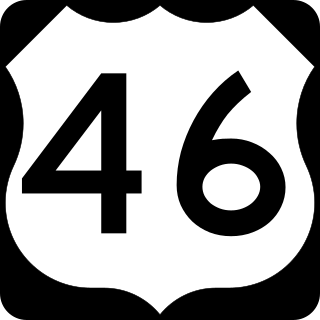
U.S. Route 46 (US 46) is an east–west U.S. Highway completely within the state of New Jersey, and runs for 75.34 mi (121.25 km). The west end is at an interchange with Interstate 80 (I-80) and Route 94 in Columbia, Warren County, on the Delaware River. The east end is in the middle of the George Washington Bridge over the Hudson River in Fort Lee, Bergen County, while the route is concurrent with I-95 and US 1-9. Throughout much of its length, US 46 is closely paralleled by I-80. US 46 is a major local and suburban route, with some sections built to or near freeway standards and many other sections arterials with jughandles. The route runs through several communities in the northern part of New Jersey, including Hackettstown, Netcong, Dover, Parsippany–Troy Hills, Wayne, Clifton, Ridgefield Park, Palisades Park, and Fort Lee. It crosses over the Upper Passaic River at several points. The road has been ceremonially named the United Spanish–American War Veterans Memorial Highway.
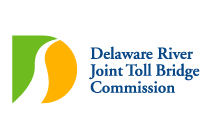
The Delaware River Joint Toll Bridge Commission (DRJTBC) is a bistate, public agency that maintains and operates river crossings connecting the U.S. states of Pennsylvania and New Jersey. The agency's jurisdiction stretches roughly 140 miles (230 km) along the Delaware River from Philadelphia and Bucks County in southeast Pennsylvania and then north through the Lehigh Valley and to Pennsylvania-New York state border.
The Belvidere-Delaware Railroad was a railroad running along the eastern shore of the Delaware River from Trenton, New Jersey north via Phillipsburg, New Jersey to Manunka Chunk, New Jersey. It became an important feeder line for the Lehigh Valley Railroad's join to the Central Railroad of New Jersey, which was constructed into Phillipsburg, New Jersey, at about the same time. This connected Philadelphia and Trenton, New Jersey at one end of the shortline railroad to the rapidly growing lower Wyoming Valley region, and via the Morris Canal or the CNJ, a slow or fast connection to New York City ferries crossing New York Harbor from Jersey City, New Jersey.

Interstate 78 (I-78) is an east–west route stretching from Union Township, Lebanon County, Pennsylvania, to New York City. In New Jersey, I-78 is called the Phillipsburg–Newark Expressway and the Newark Bay Extension of the New Jersey Turnpike. The highway runs for 67.8 miles (109.1 km) in the northern part of the state of New Jersey from the I-78 Toll Bridge over the Delaware River at the Pennsylvania state line in Phillipsburg, Warren County, east to the Holland Tunnel under the Hudson River at the New York state line in Jersey City, Hudson County. The Phillipsburg–Newark Expressway portion of I-78, formally called the Lightning Division Memorial Highway, runs from the Phillipsburg area east across rural areas of Western New Jersey before entering suburban areas in Somerset County. The road crosses the Watchung Mountains, widening into a local–express lane configuration at Route 24 as it continues through urban areas to Newark. Here, I-78 intersects the mainline of the New Jersey Turnpike (I-95) and becomes the Newark Bay Extension, crossing the Newark Bay Bridge and continuing to Jersey City. The route, along with Route 139, follows a one-way pair of surface streets to the Holland Tunnel.

The Belvidere & Delaware River Railway Company also known as Delaware River Railroad or Bel-Del, is a class III railroad in the United States. It was formed in 1995 when the Conrail Delaware Secondary line was purchased by the Black River Railroad System, which operates several railroad services in western New Jersey and eastern Pennsylvania. The Black River Railroad System also owns and operates the Black River and Western Railroad (BR&W). BR&W has leased 10 miles (16 km) of trackage to BDRV since 2004.
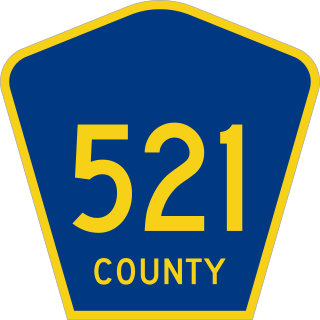
County Route 521 is a county highway in the U.S. state of New Jersey. The highway extends 43.71 miles from High Street in Hope Township to the New York state line in Montague Township.

County Route 519 is a county highway in the U.S. state of New Jersey. The highway extends 88.54 miles (142.49 km) from Daniel Bray Highway in Delaware Township to the New York state line in Wantage Township. It is the state's longest county route.

County Route 513 is a county highway in the U.S. state of New Jersey. The highway extends 66.83 miles (107.55 km) from Kingwood Avenue in Frenchtown to Lakeside Road in West Milford. South of Frenchtown, the road continues as Route 29. It is the third longest county route in New Jersey, following CR 519 and CR 527.

County Route 511 is a county highway in the U.S. state of New Jersey. The highway extends 37.44 miles (60.25 km) from Columbia Avenue in Morris Township to the New York state line in West Milford where the road continues as New York State Route 210.
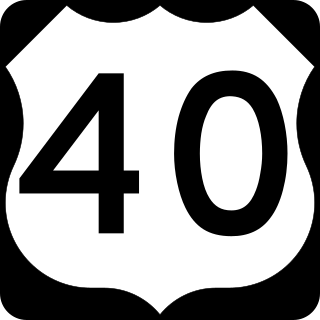
U.S. Route 40 is a U.S. highway running from Silver Summit, Utah east to Atlantic City, New Jersey. The easternmost segment of the route runs 64.32 miles (103.51 km) through the southern part of New Jersey between the Delaware Memorial Bridge over the Delaware River in Pennsville Township, Salem County, where it continues into Delaware along with Interstate 295 (I-295), east to Atlantic Avenue and Pacific Avenue in Atlantic City, Atlantic County. The route passes through Salem, Gloucester, and Atlantic counties as well as the boroughs of Woodstown, Elmer, Newfield, and Buena. The route encounters a mix of rural, suburban, and urban environs throughout its journey across South Jersey.

U.S. Route 22 (US 22) is a United States Numbered Highway stretching from Cincinnati, Ohio, in the west to Newark, New Jersey, in the east. In New Jersey, the route runs for 60.53 miles (97.41 km) from the Easton–Phillipsburg Toll Bridge over the Delaware River in Phillipsburg, Warren County, to Interstate 78 (I-78), US 1/9, and Route 21 at the Newark Airport Interchange in Newark, Essex County. The road first heads through the Phillipsburg–Alpha area as an arterial road before running concurrent with I-78 through mountainous and agricultural sections of western New Jersey between Alpha and east of Clinton in Hunterdon County. For the remainder of the route, US 22 runs to the south of I-78 through mostly suburban areas as a four- to six-lane arterial road, passing through Hunterdon, Somerset, Union, and Essex counties. Along this portion, it intersects US 202 and US 206 in Somerville, I-287 in Bridgewater Township, and the Garden State Parkway in Union.